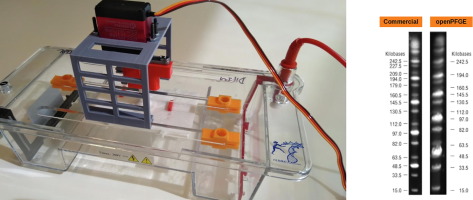
In biochemistry and molecular biology, advanced equipment is essential for research but often prohibitively expensive, limiting access for smaller labs and institutions. While open-source versions exist for some essential tools, like PCR, affordable solutions are rare, leaving a gap for labs with limited resources. The openPFGE project bridges this gap for pulsed-field gel electrophoresis (PFGE), an essential technique for separating large DNA molecules, by offering a fully open-source and low-cost PFGE device.
What is PFGE?
Pulsed-field gel electrophoresis is a specialized type of DNA electrophoresis that enables separation of very large DNA fragments, typically up to 10 million base pairs (Mb). This is achieved by periodically changing the direction of the electric field, allowing for more precise separation of DNA based on size. PFGE is widely used in genetic research, microbial typing, and the study of complex genomes. However, the high cost of commercial PFGE systems restricts access, particularly in low-resource settings.
About the openPFGE Project
openPFGE provides a solution by offering a fully open-source design for PFGE equipment, which can be built and assembled with standard, readily available components and 3D-printed parts. Developed by Diego Lagos-Susaeta, Oriana Salazar, and Juan A. Asenjo, this project uses simple, low-cost materials to create a PFGE device capable of matching the functionality of commercial counterparts for a fraction of the cost. The project aims to democratize access to high-quality PFGE equipment, enabling more labs to conduct complex DNA separations.
Key Features
- Affordable Design: Costs around $500, making it about 1/50th of the price of commercial systems.
- High Performance: Successfully separates DNA up to 2 million base pairs (Mb) with promising results in trials for 10 Mb markers.
- Open-Source Accessibility: Full documentation, 3D print files, and software are publicly available, allowing customization and collaborative improvement.
- Bluetooth and Smartphone Control: Adjust and monitor parameters through a Bluetooth-enabled Android app.
- Built with Readily Available Parts: Uses Arduino Nano for control, a servo motor for gel rotation, a Peltier cooling system, and standard electronics.
Design and Components
The design of openPFGE is based on accessibility, affordability, and ease of assembly. Here’s an overview of the main components:
- Gel Rotation System: Instead of a costly, complex rotating electric field, openPFGE achieves direction changes by rotating the gel tray itself. The system is powered by a digital servo motor, controlled by an Arduino Nano, which adjusts the angle precisely as needed.
- Cooling System: To maintain optimal temperature, which is crucial during long electrophoresis runs, openPFGE includes a 12V buffer cooling system that uses a Peltier element. A temperature sensor (NTC epoxy thermistor) monitors the buffer, feeding data back to the cooling system to keep temperatures stable.
- Control System: The core of openPFGE’s control system is an Arduino Nano, which allows users to set and monitor parameters on an OLED display. The device also includes a Bluetooth module for remote control via a smartphone, providing convenience and further reducing the need for specialized software.
- 3D Printed Parts: The parts needed for assembly, including the gel tray and rotation system, can be 3D-printed, making the setup easy and accessible. The design files are available for download, enabling labs to customize the parts as needed.
Performance and Results
Despite its affordability, openPFGE performs comparably to commercial PFGE systems. In trials, it successfully separated DNA fragments up to 2 million base pairs (Mb), meeting standard research needs. Testing is underway with a 10 Mb DNA marker, and early results are promising. By using openPFGE, labs can achieve high-quality separation at a fraction of the cost.
Cost and Accessibility
One of the most significant advantages of openPFGE is its cost: approximately $500, which is about 1/50th of the price of most commercial PFGE systems. This drastic reduction in cost opens up PFGE technology to a much wider range of labs, particularly in resource-limited settings, enabling more scientists to conduct advanced molecular biology experiments.
How to Build and Use openPFGE
openPFGE provides full instructions for assembly, which involve acquiring components, 3D printing parts, and assembling the electronics. Here’s a brief overview of the steps:
- Acquire Components: All necessary components, including the Arduino Nano, servo motor, and temperature sensor, are listed in the project documentation on GitLab.
- 3D Print Parts: Use the provided 3D print files to create the gel tray, tray cover, and other essential parts.
- Assemble Electronics: The circuit board layout is available for download, and components can be soldered onto the board according to the provided schematics.
- Download the Android App: Control openPFGE via a custom Android app, which enables users to monitor and adjust parameters in real-time.
The detailed assembly instructions, along with pictures, are available on the GitLab project page.
The openPFGE project is a transformative tool for labs seeking an affordable, reliable alternative to commercial PFGE equipment. By leveraging open-source design and accessible materials, it provides researchers worldwide with the means to perform advanced DNA separations without the high costs. openPFGE not only democratizes access to crucial molecular biology technology but also empowers labs to customize and improve upon the design, fostering a collaborative approach to scientific advancement.

